This is another guest post by my awesome wife, who took in a lesser-traveled slice of Rome during our three-month trip across Europe.
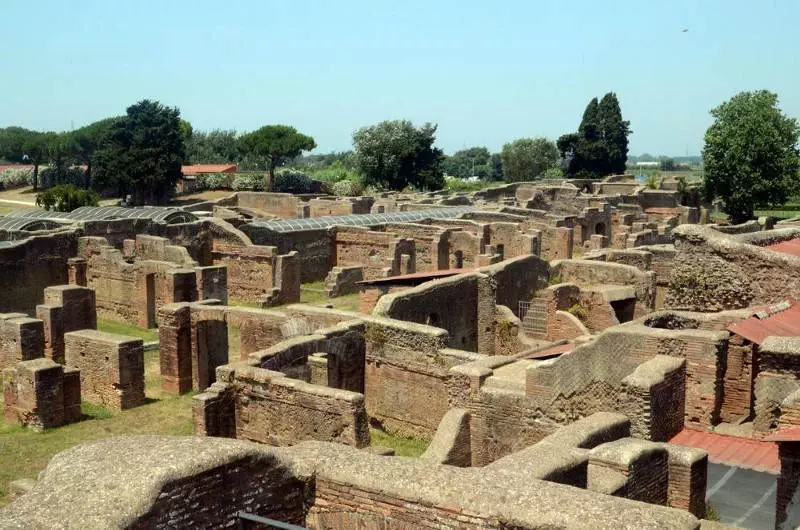
There are a lot of destinations featured here on Worthy Go. With most of the more off-the-beaten track places, it’s not hard to see why they’re not on the beaten track — no matter how good a place is, if it’s hard to get to, if it’s only of interest to a few people, if it’s just too small to be worth most people’s while, or if it’s in an area few tourists visit… in cases like that, it’s not hard to understand why there are so few people there.
Today, however, I am going to tell you about a place that’s comparatively lesser known and lesser-visited for none of the above reasons. It’s easy to get to and close to one of the most touristed areas in the world (just half an hour on a direct suburban train from Rome), it’s of great interest to many people (Roman ruins), and it’s huge (I spent three hours and didn’t come close to seeing everything).
As far as I can tell, the only reason for Ostia’s relative obscurity is that it’s close to some of the real behemoths in the tourist industry, bucket list types of places. It’s slightly harder to get to than Palatine Hill and the Colosseum, and it’s not preserved as well, nor does it get the same kind of press as Pompeii and Herculaneum, which are similar types of destinations. Of course, everyone’s heard of Pompeii. I went to Pompeii. It was a childhood dream come true, and I could easily have spent a week in Naples just visiting Pompeii over and over again daily had I had the time. Pompeii is incredible… but I preferred Ostia.
So, what’s Ostia (technically, Ostia Antica)? It’s the ruins of a Roman port city. It sat at the mouth of the Tiber and thus served as the seaport for ancient Rome. It may have been founded around the seventh century BC, though of course it changed a lot over time — the oldest ruins you can see there now are “only” from the third century BC. At its peak in the second or third century AD, it’s thought to have been a town of about 100,000 people which had temples, a Christian church and even a synagogue. There was no great tragedy that destroyed the city; it just sort of faded away with the fall of Rome, repeated sackings, and the ravages of time, and was gradually buried.
Excavations began in the early 19th century and continue today. The city is remarkably well preserved, especially given that no one ever really tried to preserve it. It just kind of got lucky. Most of the site is pretty much just piles of old bricks (and I say that as a lover of piles of old bricks), but there are still frescoes and mosaics, and the buildings mostly maintain their original shapes so that you can easily imagine what might have been happening there centuries ago.
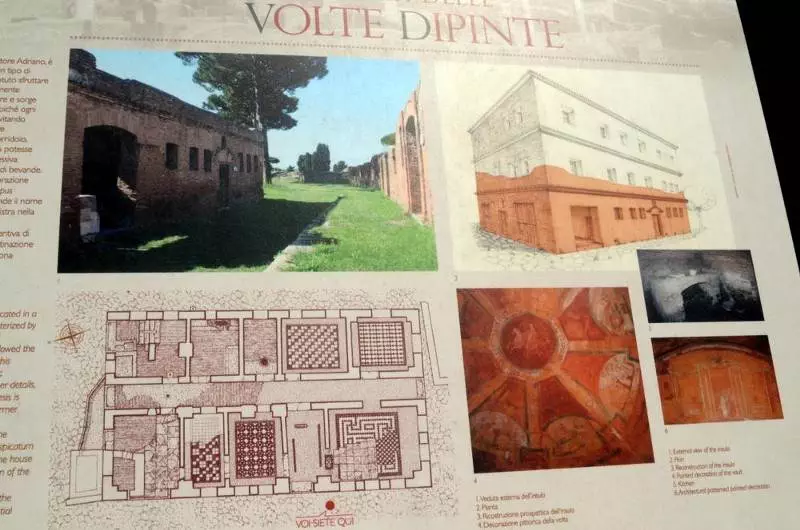
Here, I have to point out two ways in which Ostia is a much more pleasant site to visit than Pompeii. First of all, signage! There is almost none in Pompeii. There are signs on every important building in Ostia. They tell you what the building was and include little maps with points of interest as well as sketches of what archaeologists think that building may have looked like. You’re going to learn a lot more here, as an independent tourist, than you ever would in Pompeii.
The second thing that’s great about Ostia is exactly what I led off with: there aren’t a lot of other tourists there. You’re not going to be alone, but you’re also not likely going to stand in a long line at the ticket window, and you’ll be able to get pictures of the place itself rather than the place with lots of oblivious tourists in front of it.
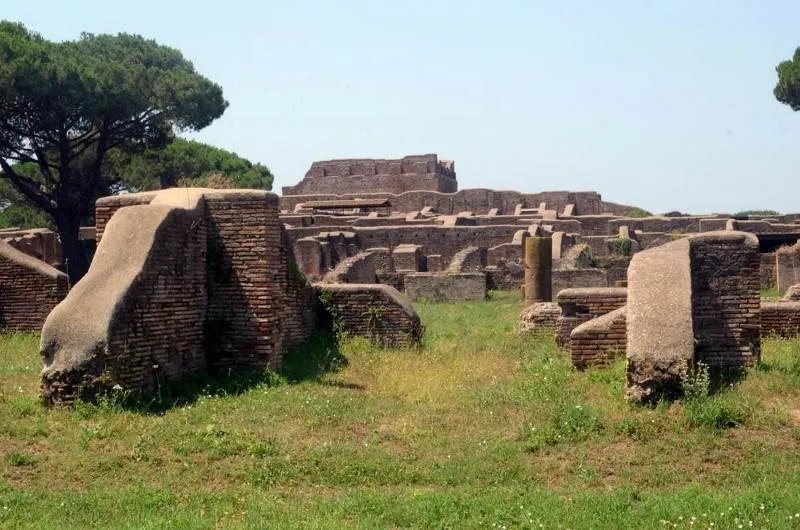
And here’s one thing that’s not so great about either Pompeii or Ostia: you’re going to be doing a lot of walking and Italy gets really hot in summer. Wear comfy shoes and clothes, bring a water bottle or two (there are lots of places to refill, and they’re marked on the maps) and don’t forget to wear sunscreen.
So, let’s explore the site a bit! Like I said, there’s a lot here and this would be an extremely long post if I were to explain everything I saw, so I’ll show a few highlights. Personally, I’m much more interested in everyday Roman life than in their government or religion, so highlights for me (here, and at Pompeii and Herculaneum) were the everyday places — the fast food shops, apartments, bakeries, laundries, and homes.
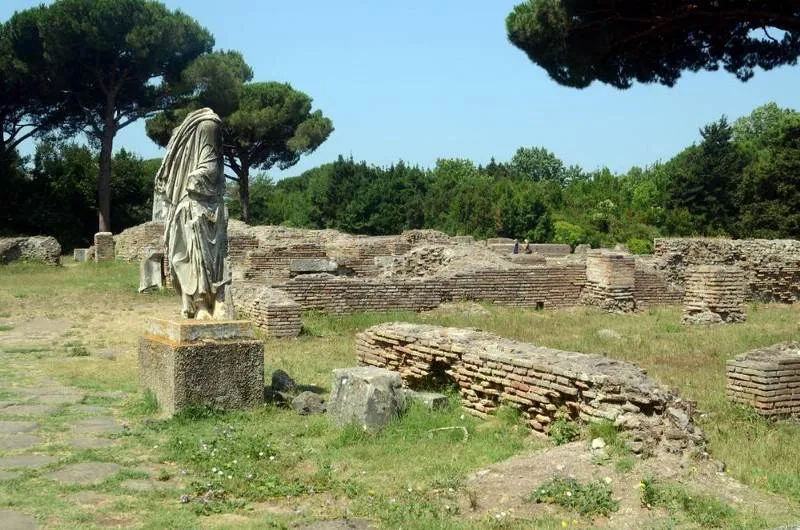
You start at one end of the Decumanus Maximus, which was the city’s main road, in the Necropolis. There are about sixty tombs and, like all Roman necropolises, they’re spread along the road leading into/out of the city — a cheerful welcome, I must say. The earlier burials took place in a columbarium, pictured below.
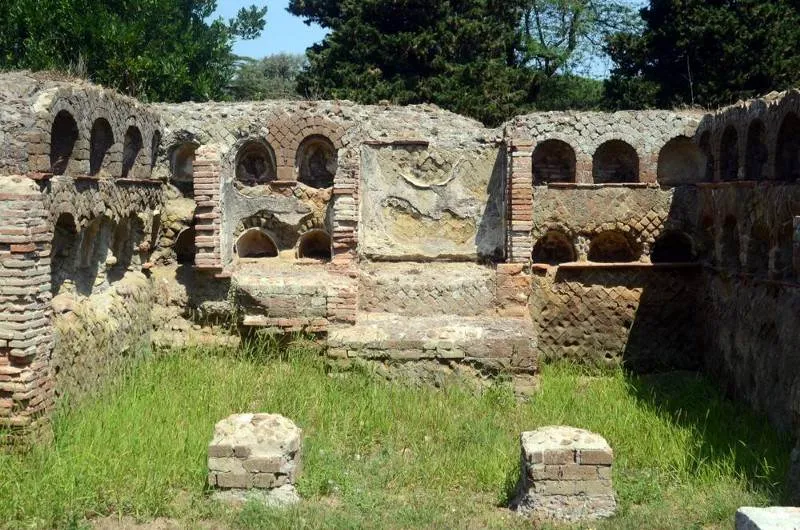
The niches would have been filled with cremation urns. This gave way to inhumation around the second century AD, and you can see some of the sarcophagi around the site, though their remains are long gone.
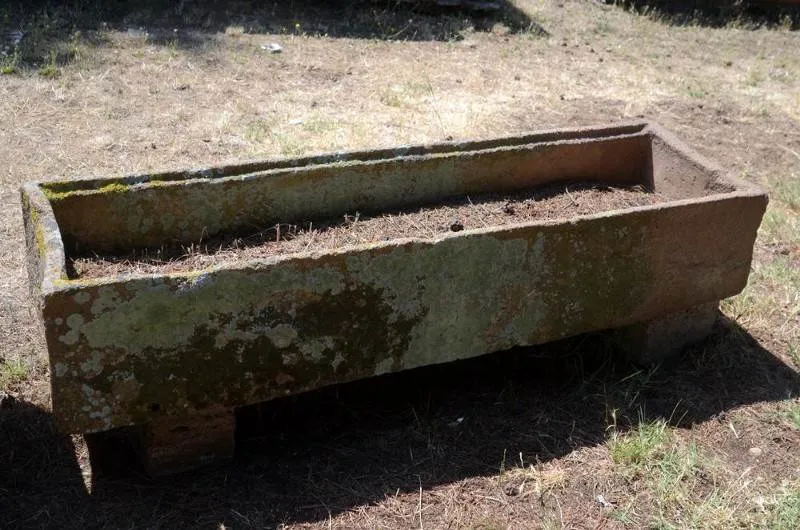
Below is a Roman fast food shop. It’s pretty much identical to those found in Pompeii. Average Romans generally didn’t have kitchens in their apartments, so they just ate out all the time. The name for a shop like this is a thermopolium, and it pretty closely resembles its modern equivalent — it has a shop counter, places to wash dishes, and even outdoor seating.
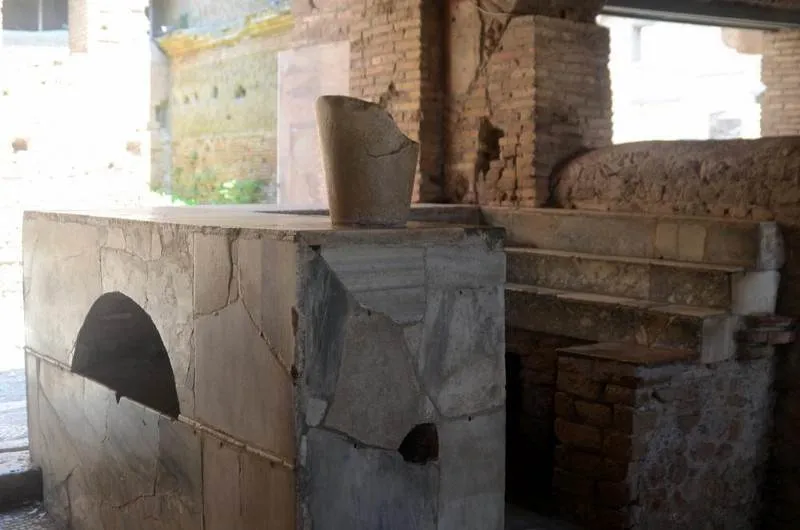
The fresco on the wall is pretty topical:
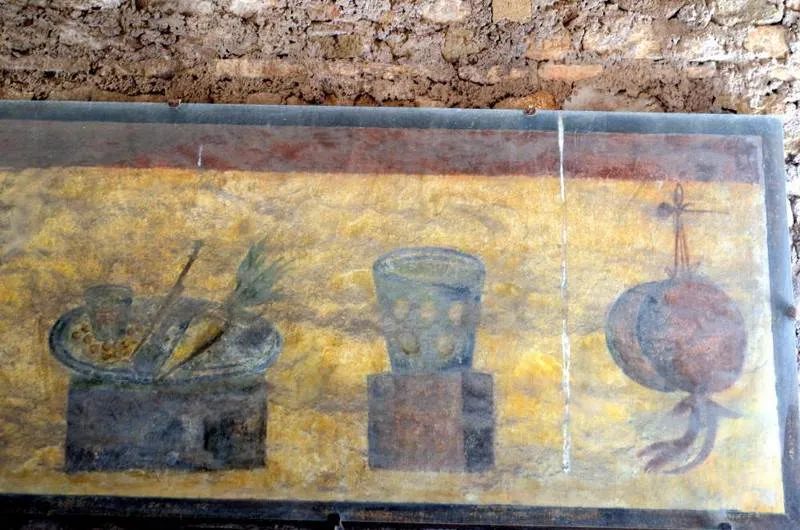
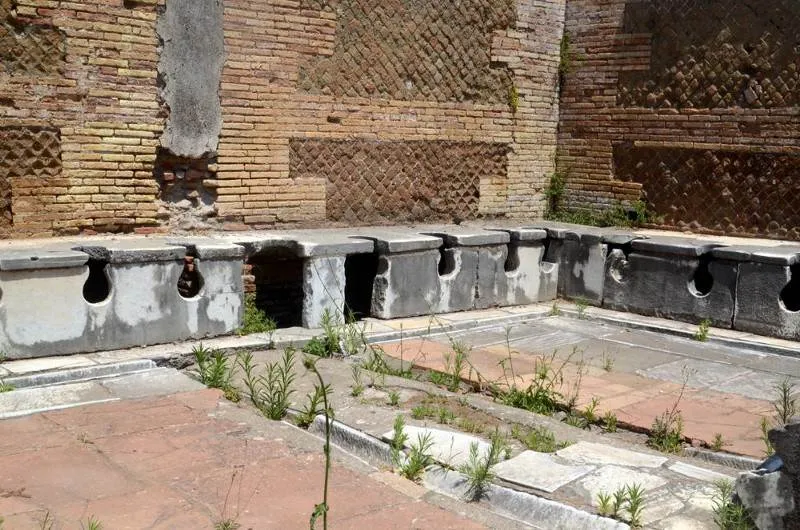
Some time (hopefully not too little time) after visiting the thermopolium, an Ostian would have wanted to come here — the public latrine. The VERY public latrine. It is, uh, actually in better shape than the modern latrines at the site on the day I visited…
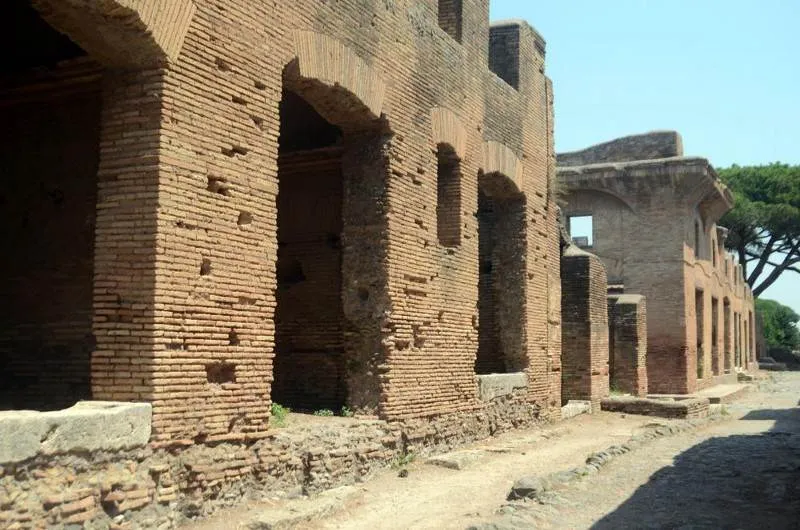
This, the Casa di Diana, was an apartment block. The lower the income level, the higher, darker and smaller the apartment. Many residential buildings were actually shops on the first floor with residential areas above; this building plan may be familiar to those of you who have been to Thailand, among other places. The Casa di Diana is remarkable in that you can actually go all the way to the third floor (in most cases, only the first floor of buildings that survived at all is still around), which gives you a nice overview of some of the site.
Also like Thailand, it was pretty common to have a little shrine with the household gods somewhere in the building. Whatever was in there has long since disappeared, but here’s one of the shrines:
One of my favourite parts of the site was the Piazzale delle Corporazioni. This is believed to have been where various guilds had their office (though archaeologists aren’t completely sure), and what makes it interesting is that each guild’s office had a little mosaic out front showing what that shop specialized in. An elephant, for example, might indicate trade in goods from Africa:
Ships and fish were popular mosaic subjects; not really surprising given that this was a port city:
Moving farther into the city, it’s hard to miss the amphitheatre — honestly, not much compared to those in Rome or in El Jem, but still cool.
Of course, no Roman city would be complete without its share of public baths. Ostia had the Baths of Neptune, with some topical mosaics on the floor (sadly, a lot of this was covered during my visit — preservation of a site like this takes a lot of work).
Meanwhile, the Baths of the Forum, farther inside the city, give us a pretty good idea of how the whole system worked. You can even see some of the pipes.
The baths are, of course, named after the Forum, which was the main square of the city and surrounded by other important buildings.
There’s a lot more to see, and this blog post really only gives a small sample — there are some wealthier houses with nice mosaics and frescoes, and just a ton of little shops and taverns (a whole street of taverns, in fact, if archaeology is to be believed). There’s also a small museum (admission included in your ticket price) which has a few statues and other objects found at the site (but don’t feel too bad if you don’t get to it — it’s fairly small). For more information on the site than you could possibly absorb, please visit http://www.ostia-antica.org/ — it’s been immensely helpful to me in finding information about the city, and it explains pretty much everything currently known about every building there.
Name: Ostia
Address: Viale dei Romagnoli, 657, 00119 Roma RM, Italy (GPS: 41.758007, 12.298535)
Directions: First, get yourself to the Roma Porta S. Paolo train station, which is right next to the Piramide metro stop on line B. The train makes a few other stops in Rome, but this is likely to be the most convenient for you; also, bear in mind that this same train goes to the beach, so it’s not a great idea to try to take it on a summer Sunday as I did. If you do take it on a summer Sunday, you absolutely must get on at or before S. Paolo or you won’t be getting on at all. Take this train to the Ostia Antica stop. Coming out of the Ostia Antica station, turn left down Via Ostiense and then take the first right to an overpass that goes over a highway. Cross this overpass and continue straight until you reach the site entrance.
Hours: Opens at 8:30 and closes anywhere from 4:30 to 7:15 depending on the date. Last entry one hour before closing. See here (http://www.ostiaantica.beniculturali.it/en/orari-ostia-antica.php) for precise closing times. Museum opens at 9:30.
Admission: 10 euros for adults, 6 euros reduced, free for kids under 18
Phone:
Website: http://www.ostiaantica.beniculturali.it/en/index.php (for tourist information); http://www.ostia-antica.org/ (helpful reference)
(Note: There are no convenience facilities except in a small group near the museum. There are plenty of drinking water taps around the site, which is really the most important thing as long as you remember to pee beforehand and/or are prepared to pee on archaeological ruins (note: please do not pee on archaeological ruins.))


